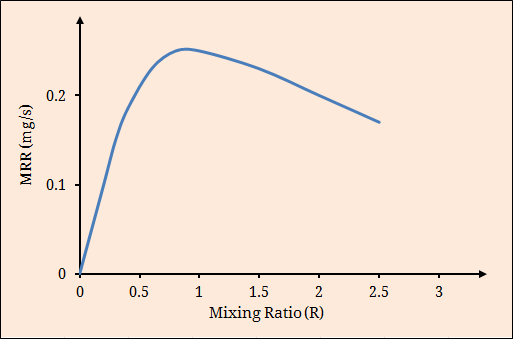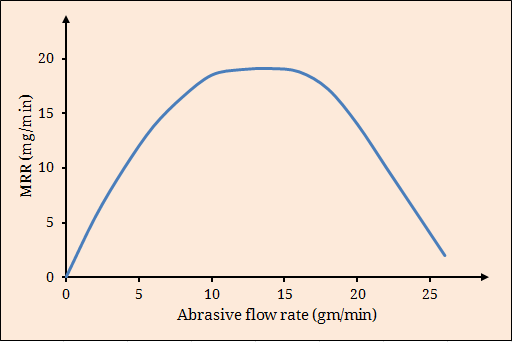In abrasive jet machining (AJM), fine abrasive particles, accelerated by pressurized dehumidified carrier gas are allowed to strike the work surface in the form of a jet with the help of a nozzle. This high velocity abrasive jet gradually erodes material from work surface. Proportion of abrasive presents in abrasive jet is one crucial factor as it determines machining performance as well as quality of cut. This proportion is basically identified and defined by a parameter called Mixing Ratio.
What is mixing ratio in abrasive jet machining?
By definition, mixing ratio is the ratio between mass flow rate of abrasive grits and mass flow rate of carrier gas, as shown below. Although, many proponents define mixing ratio using volume flow rates (instead of mass flow rates), the basic parameter and its influence remain unchanged.

Effects of mixing ratio on MRR
When mixing ratio is increased by increasing abrasive flow rate—Both the material removal rate and surface finish in abrasive jet machining (AJM) are associated with the value or variation in mixing ratio. Mixing ratio can be increased by pumping more abrasives keeping gas flow rate unchanged. In such case, MRR will improve as higher number of abrasives will strike the work surface per unit time resulting higher erosion rate. However, if mixing ratio is increased just by adding abrasives beyond a certain limit, then jet velocity will also descend substantially (as gas flow rate is constant) and the result will be degraded erosion rate or lower MRR. The following graph depicts how MRR changes with mixing ratio in AJM.

When mixing ratio is kept constant by increasing both abrasive and gas flow rate—However, if both abrasive flow rate and gas flow rate are increased proportionally maintaining mixing ratio constant, then a steady increase in material removal rate (MRR) can be noticed. This is attributed to the fact that simultaneous increase in abrasive and gas flow rates keeps jet velocity unaltered but allows more number of abrasive grits to participate in cutting action per unit time. But this requires thicker pipelines and accessories to handle higher gas pressure without failure. Thus for an existing system, maximum gas pressure is limited by the capability of set-up.

Effects of mixing ratio on cut quality
Mixing ratio also affects cut quality. When the jet abounds in abrasives, the machining zone fills with excessive used grits, which restricts free flow of jet by haphazard and repeated collision that results in spreading of jet. Eventually surface quality and tolerance of machined profile degrade. An optimum mixing ratio provides better result in terms of surface quality and tolerance.
References
- Book: Nonconventional Machining by P. K. Mishra (Narosa Publishing House).
- Book: Nontraditional Manufacturing Processes by G. F. Benedict (Manufacturing Engineering and Materials Processing-19).
- Book: Unconventional Machining Processes by T. Jagadeesha (I. K. International Publishing House Pvt. Ltd.).